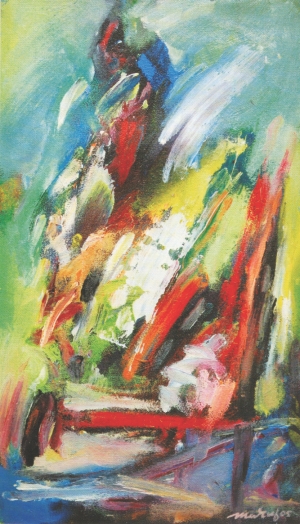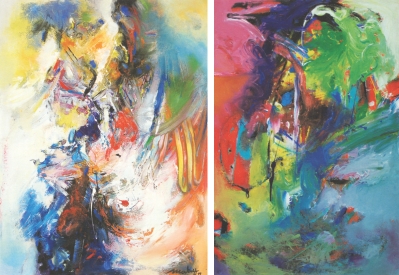| Home - Back Issues - The Team - Contact Us |
 |
| Volume 11 |Issue 04| January 27, 2012 | |
|
|
Art Colours from Bonn to Bangladesh Fayza Haq
Despite being in his sixties, Maruf Ahmed can manage to attract attention. In his jeans, and black leather jacket, Ahmed looks cool, calm, and collected, with his brand of joi de vivre. A DAAD scholar, Ahmed studied in Cologne. “I have learnt of Dadaism. Surrealism, Fauvism. I believe that that the Post-Colonial days have not been as evil or unconstructive, as some artists might believe to be. I think that after the World War II, and later on, in the Cold War period, artists had to be realistic, and make room to have food, clothes and shelter for himself, and for those who depended on them, like my young son and daughter—who are wonderful to come home to, after the 'hard day's work, as the Beatles put it,” says Maruf Ahmed. Ahmed not only feels like Van Gogh, but also Gauguin, who made it important to include women's feeling and emotions—the women with whom he shared his life. It wasn't enough that he painted to make room for his palette-knife, brush and paints. Yes, the artist has to keep the patron, whoever and whatever it is, and be true to himself and his muse that inspires him. The artist, says Maruf Ahmed, doesn't have to make visible sails, boats, “ek-tara” player, peacocks and bullocks, fish and fowls, to make the viewer long to see the artist's place of origin. He says that he doesn't have to bring in visible horses and elephants, in order to make the art buff aware of the country of his origin. After going through years of realism, Ahmed wants to express himself, in a manner, akin to artists in Germany, France, England, and the rest of Europe, where heavy lashings of oils on canvas sell. “The artist is a winner and go-getter. He takes pride in bringing home the bread, butter and jam. He loves getting a cuddle and giving one too. He says that the home is where the hearth is, and painting is a way to it,” says Ahmed. From where he chooses to work in, Bonn, pollution of any kind is not a common factor, as in a South Asian country like Bangladesh, although he is proud of his place of origin, Sylhet. Maruf Ahmed, who has an experience of 40 years behind him, chose his career in the seventies, with figurative work in water, colour and oil. He used them for realistic sketches, in oil and water-colour. In his early work, he brought in lyrical and gentle, fluid colours. He made landscapes and nature studies. Going into the non-figurative, shortly, he used straight lines and raw striking colours, of blue, red and yellow powerful strokes were applied, in a happy, confident mood. His earlier style was not ignored in his later themes. There were, however, subtle back drops of loud strokes. The Bonn artist's paintings, today as we see them in the Bengal Gallery and as we saw them two decades earlier, continue to sing and dance with colours. The colours take shape and forms, if we look at the paintings long enough. We find lovers or a suggestion of a face. The thick strokes present a happy, contented game of colours. The play of light and shade of colours, which the artist says he has learnt from paintings belonging to the sixteenth and fifteenth century artists and even before them, has gone into his own works as inspirations. The expressionism, which we see today in the artist's work, has well-blended forms that seem to oscillate with a mystery and magic of their own. The abstract-expressionism, which came into existence in the 1850s, is seen repeatedly in the paintings of Maruf Ahmed, guided by his intellect, inspired by European artists. Today they inspire our own artists, especially those of the younger generation.
For the Bonn-based artist, painting means bringing together oil works with canvases of nine feet by six. He has turned away from pessimism to a buoyant world of colours that cry of joy and success. “An artist should not have to destroy his soul mate and his source of inspiration,” says Ahmed. If he is taking up another source of income, such as making props for a television programme, or painting on clothes and selling them here and overseas, or doing book illustrations there is no harm in this, Maruf Ahmed believes. One needs patrons like the Bengal Gallery or Shilpakala Academy, or even the Goethe Institute. “The young artists should be taken to the Venice Biennale, which Bengal Gallery is doing,” says Maruf Ahmed. “The galleries are mushrooming up, and I'm proud of their existence and their constant help and camaraderie,” he adds. Through his brush and canvas, Ahmed aims at doing something positive for his fellow men. His earning is his incentive and security. Supporting oneself is a global problem. In Germany, out of 10,000 artists, only five of them can support themselves by painting he claims. Whereas I give lectures, arrange workshops and get teaching jobs, claims Ahmed. “But Thank God I don't have to rely on them for my wellbeing or security. I cannot afford to have a permanent job as it hampers my work,” explains Ahmed. “I'm so busy that I can't afford to come and spend a few months in Bangladesh—when I do, it is seldom, and with specific invitation,” he says. Stating the poor conditions of artists in Europe, Ahmed explains that even getting a job is a hassle in Europe due to competitions. Qualifications are necessary in Europe, and so individuals go in for serving as stewards in pubs and restaurants.” What exactly does he wish to capture in his canvas? Does he want to mix and mingle the experiences of the past with the hopes for the future? The artist does not wish to give a message; he doesn't wish to mix himself up with a conception, says Ahmed. As a painter, with his deep, unconscious mind within himself, being brought up in a colourful country, he wishes to reflect it as well as where he is staying, along with the wonderful experiences there. Despite the poverty of the Bangladeshi people, they work on bravely, he says. All this he wants, as a painter to reflect. He wishes to portray the joy of life in painting. In Europe, life is definitely more materialistic, he says. “In 2007, I wanted to do something different for the flood affected areas in my country. I admire their perseverance, despite pain and constant struggle.” says the artist. How does he feel about the experimentation with people and place, as did Britto in the past many years, under the guidance of Lipi and Mahmud? The artist says, “The development of work here in Bangladesh is good but limited. A lot of artists are experimenting and exchanging ideas and their experiences. Artists are going in for video, installations and audio. There is more of intellectual work in this. It is appreciable that artists are more open-minded than before. The young artists should also keep in mind what their forefathers had to go through during the Freedom Movement and the struggle for liberation. We now have an identity, which we've never had before. The thinking of the younger generation of artists is more liberal. I myself belong the generation of the 60s and 70s and still I look ahead to 2012. As Muntasir Mamun puts it, the past had a lot to do with the world-wide focus of the present generation.” What is his concept of a true artist, keeping in mind that the word “true artist” has been played with quite a bit. Maruf Ahmed says, “Gauguin was more conscious about his life as Van Gogh was not, speaking about two major artists, who always egg on painters. Artists today are doing works, which may not be appreciated today. But one hopes for a future...” says the master painter. Copyright
(R) thedailystar.net 2012 |
||||||||

